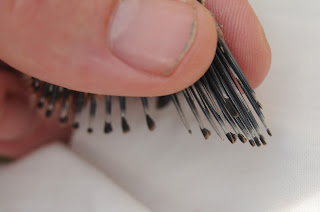The duck net caught three of a family of five Australian Wood Ducks, including both parents. A Grey Teal was caught late in the morning.
Despite the wind the rest of the nets kept up a steady trickle of birds including Grey Fantail, Yellow-rumped Thornbill and two Rufous Whistlers.
 |
| Adult female Rufous Whistler. Note the all black bill and the red eye. The streaking on the throat is not well shown in this picture, but is not as dark and thick as juvenile birds. |
 |
| The back of the female whistler. Tail shape is an important character in ageing these birds - this one had broad, round-tipped feathers typical of adults. |
Looking at the nestlings we could see that they were at the perfect age to be banded. That is, when the feathers have just started emerging from their sheaths. Before this the birds are too small, and much later than this the birds are big enough to try and leave the nest. The three pulli were quickly banded and the parents were happily attending to them the next time I walked past.
This was also a good learning experience for our trainee banders as we don't get to band nestlings often at Herdsman.
 |
| The growing feathers have just broken tips of the feather sheaths - the perfect age for pullus banding. |
 |
| Willie Wagtail pulli, ready to be banded. |
Species - New (retrap)
Australian Wood Duck - 3
Brown Honeyeater - 1 (1)
Grey Fantail - (1)
Grey Teal - 1
New Holland Honeyeater - (2)
Rufous Whistler - (2)
Silvereye - 4 (5)
Willie Wagtail - 3
Yellow-rumped Thornbill - (4)
Total - 12 (15) = 28

No comments:
Post a Comment